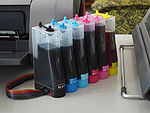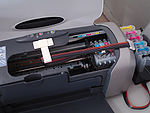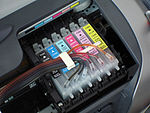| Revision as of 03:54, 11 November 2007 edit70.22.94.11 (talk) Removing advertisement section that does nto contribute to the meaning of the article← Previous edit | Revision as of 05:38, 11 November 2007 edit undo75.84.24.21 (talk)No edit summaryNext edit → | ||
| Line 6: | Line 6: | ||
| A '''Continuous Ink System''' (CIS) also known as Continuous Flow System (CFS), Digital Image Prints System (DIPS) and bulk feed ink system, is a cost-effective replacement for ] ]s. In contrast to conventional cartridges, a CIS/CFS uses very large (about 100ml/color) ink tanks, which are connected with tubes to the printhead nozzles. The tanks can be conveniently refilled from an ink bottle - there is no need for syringes. | A '''Continuous Ink System''' (CIS) also known as Continuous Flow System (CFS), Digital Image Prints System (DIPS) and bulk feed ink system, is a cost-effective replacement for ] ]s. In contrast to conventional cartridges, a CIS/CFS uses very large (about 100ml/color) ink tanks, which are connected with tubes to the printhead nozzles. The tanks can be conveniently refilled from an ink bottle - there is no need for syringes. | ||
| The first known desktop printer bulk feed system was developed by http://www.nomorecarts.com in 1998 and later by http://www.inksupply.com (MIS Associates, Inc.)In 1999 for the Epson 640 printer. The first "Spongeless CIS" was designed by http://www.inkrepublic.com (InkRepublic) in 2002 using |
The first known desktop printer bulk feed system was developed by http://www.nomorecarts.com in 1998 and later by http://www.inksupply.com (MIS Associates, Inc.)In 1999 for the Epson 640 printer. The first "Spongeless CIS" was designed by http://www.inkrepublic.com (InkRepublic) in 2002 using advanced spongeless damper with high quality tubing. InkRepublic is also the first pigment-based CIS provider. After this first success many more CFS systems were developed to cover most Epson and Canon printers. These bulk feed systems also can allow users to use inexpensive aftermarket inkjet inks as well as specialty inks like HT Heat Transfer inks for T-Shirt transfers or Black and White inks for gallery quality B&W printing. These options have allowed users to produce specialty prints at a fraction of the cost of purchasing special cartridges or using more expensive printing solutions. | ||
| The inkjet printer industry has viewed continuous flow systems as a threat to profits from sale of ink cartridges, while high volume users demand lower cost ink{{Fact|date=March 2007}}. The result has been an arms race - the manufacturers have changed ink formulae, smart chips, printer & cartridge models so frequently that the CIS suppliers have had difficulty keeping up{{Fact|date=March 2007}}. Recently CIS manufacturing has shifted from a "one of a kind - customization" cottage industry to higher volume mass market production as Chinese engineers realized the market potential{{Fact|date=March 2007}}. The result has been a significant reduction in pricing of a CIS{{Fact|date=March 2007}}. System prices have dropped from the $500 range to less than $100. | The inkjet printer industry has viewed continuous flow systems as a threat to profits from sale of ink cartridges, while high volume users demand lower cost ink{{Fact|date=March 2007}}. The result has been an arms race - the manufacturers have changed ink formulae, smart chips, printer & cartridge models so frequently that the CIS suppliers have had difficulty keeping up{{Fact|date=March 2007}}. Recently CIS manufacturing has shifted from a "one of a kind - customization" cottage industry to higher volume mass market production as Chinese engineers realized the market potential{{Fact|date=March 2007}}. The result has been a significant reduction in pricing of a CIS{{Fact|date=March 2007}}. System prices have dropped from the $500 range to less than $100. | ||
Revision as of 05:38, 11 November 2007
| Template:Wikify is deprecated. Please use a more specific cleanup template as listed in the documentation. |



A Continuous Ink System (CIS) also known as Continuous Flow System (CFS), Digital Image Prints System (DIPS) and bulk feed ink system, is a cost-effective replacement for ink-jet printer cartridges. In contrast to conventional cartridges, a CIS/CFS uses very large (about 100ml/color) ink tanks, which are connected with tubes to the printhead nozzles. The tanks can be conveniently refilled from an ink bottle - there is no need for syringes.
The first known desktop printer bulk feed system was developed by http://www.nomorecarts.com in 1998 and later by http://www.inksupply.com (MIS Associates, Inc.)In 1999 for the Epson 640 printer. The first "Spongeless CIS" was designed by http://www.inkrepublic.com (InkRepublic) in 2002 using advanced spongeless damper with high quality tubing. InkRepublic is also the first pigment-based CIS provider. After this first success many more CFS systems were developed to cover most Epson and Canon printers. These bulk feed systems also can allow users to use inexpensive aftermarket inkjet inks as well as specialty inks like HT Heat Transfer inks for T-Shirt transfers or Black and White inks for gallery quality B&W printing. These options have allowed users to produce specialty prints at a fraction of the cost of purchasing special cartridges or using more expensive printing solutions.
The inkjet printer industry has viewed continuous flow systems as a threat to profits from sale of ink cartridges, while high volume users demand lower cost ink. The result has been an arms race - the manufacturers have changed ink formulae, smart chips, printer & cartridge models so frequently that the CIS suppliers have had difficulty keeping up. Recently CIS manufacturing has shifted from a "one of a kind - customization" cottage industry to higher volume mass market production as Chinese engineers realized the market potential. The result has been a significant reduction in pricing of a CIS. System prices have dropped from the $500 range to less than $100.
To avoid the need to remove the cartridge and reset the smart chip every time the chip thinks the cartridge has run out of ink, CIS often reverse engineer the smart chip and build a custom version that automatically resets itself. Software drivers for the printer may balk at these third party chips and workarounds are sometimes required.
One major feature of a CIS in addition to the savings from reduced demand for ink cartridges, is the ability to use special inks..
This computer hardware article is a stub. You can help Misplaced Pages by expanding it. |